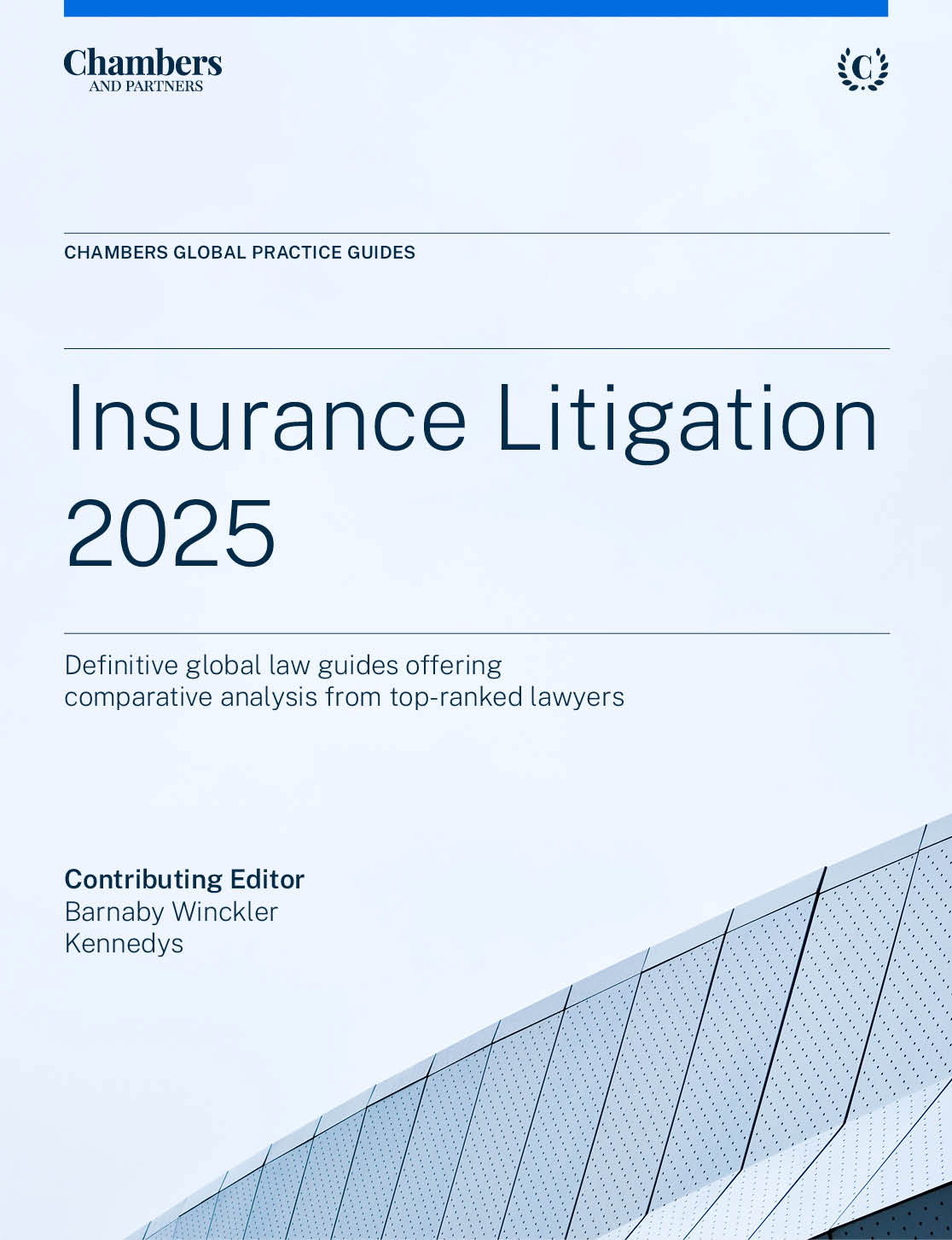
Insurance Litigation 2025
The Insurance Litigation 2025 guide features 20 jurisdictions. The guide provides the latest legal information on alternative dispute resolution (ADR), the enforcement of foreign judgments, the applicability of the New York Convention, coverage disputes, claims against insureds, insurers’ recovery rights, and the impact of data privacy concerns and climate change on insurance litigation.
Last Updated: October 02, 2025
Compare law and practice by selecting locations and topic(s)
Select Locations

Select Topic(s)

Please select at least one location and one topic to use the compare functionality.
The Ongoing Impact of War, Disease and ESG on the Global Insurance Litigation Landscape
The 2025 edition of this global practice guide to insurance litigation enumerates the respective laws and rules governing insurance disputes in jurisdictions spanning each of the world’s continents, bar Antarctica. Yet the guide also extends its lens of analysis to cover concomitant issues such as how litigation is funded, along with other pertinent aspects of dispute resolution in each jurisdiction that particularly impact insurers.
Legal practitioners from each of the featured countries report in detail on significant local trends in policy coverage disputes, as well as recent shifts in the litigation of claims whereby insurers fund the defence of insureds. Such claims in China, for example, arise most commonly in liability insurance lines and are clearly increasing in terms of both the cost and complexity of litigation.
Meanwhile, there has been a noticeable rise in large group actions against major Danish companies as litigation funding becomes more common – many of which trigger cover under D&O insurance policies. These cases often involve huge claims for damages and the volume of case material can be considerable, requiring extensive documentation and resulting in substantial legal costs for insurers in defending these claims.
How macroeconomic factors are impacting insurance-related litigation
The impact of macroeconomic factors ‒ for example, the ongoing effects of the war in Ukraine and the COVID-19 pandemic ‒ on the volume and type of litigation (notably, insurance-related litigation) is also examined.
The COVID-19 pandemic has given rise to specific coverage issues that have continued well into 2025, with a prominent example being the Danish Supreme Court decision of 2 May 2025 as to whether an injury sustained by an employee while working from home during lockdown constituted a compensable work accident under the Danish Workers’ Act. In recognising the incident as a “work accident”, the Danish Supreme Court set a precedent that injuries sustained during home-based work are generally covered, even if private domestic conditions contribute to the accident (in this case, tripping over a personal object while making a cup of coffee). The outcome of this case is expected to have far-reaching implications for insurers and policyholders alike, broadening the interpretation of what constitutes a work-related injury (particularly in the context of remote work, which has been normalised in many jurisdictions following the restrictions imposed owing to COVID-19).
Macroeconomic factors continue to affect both the scope of insurance coverage and insurers’ risk appetites, with insurers tending to tighten coverage in response to events such as pandemics and wars – for example, by introducing exclusions related to infectious diseases or the risk of war. At the same time, insurers have become more cautious in underwriting risks in high-risk industries and regions, leading to higher premiums, increased deductibles, and more restrictive coverage terms and conditions.
The ongoing geopolitical instability, including the war in Ukraine, is likely to heighten the risk of cyber-incidents. The increasing frequency and sophistication of cyber-attacks is expected to cause more disputes in cyber-insurance coverage. Although it remains unclear whether a cyber-attack was the primary cause of the Iberian Peninsula blackout of 28 April 2025 (in which electric power was interrupted for up to 15 hours), the event triggered a surge in claims for business interruption, property damage, and loss of profits, as well as disputes over exclusions (power failure, force majeure, cyber-risk) and sub-limits. The Spanish Trends and Development chapter of this guide explains how public and industry reports have anticipated a significant volume of potential losses for insurers, prompting more sophisticated litigation strategies (expert evidence and concurrent causation analysis, among others).
Effect of ESG factors on insurance litigation
Environmental, social and governance (ESG) factors – from climate change and natural catastrophes to human rights – continue to play an increasingly important role in the insurance industry, progressively influencing both the underwriting of insurance risks and claims practices around the globe.
The rise of ESG-related litigation in 2025, particularly in connection with D&O liability policies, means ESG compliance has become a decisive factor in underwriting and claims handling. Lawsuits increasingly target directors for alleged “greenwashing” and failure to adopt preventative environmental measures, as well as cybersecurity breaches, lack of diversity in governance, and insufficient transparency in executive remuneration. Court rulings in these claims in various European jurisdictions are expected to shape the interpretation of policy exclusions and the scope of coverage for ESG-related risks. This evolution is turning D&O insurance into a key risk management tool, not only for financial protection but also for driving good corporate governance and sustainable business practices.
In underwriting, insurers are now placing greater emphasis on identifying and managing environmental and social risks. Insurers in the renewable energy, green construction and ecological protection sectors have developed innovative products such as green insurance and carbon sink insurance. On the asset side, insurers have scaled up green investments, thereby aligning underwriting with sustainable finance.
ESG scores are also being adopted as reference criteria for underwriting and pricing decisions, thus encouraging insureds to improve their ESG performance. If the insured performs poorly in ESG areas, this can lead to reputational damage, regulatory scrutiny and legal challenges – all of which may result in insurance claims. Therefore, some insurance companies are beginning to incorporate ESG factors as a risk on a par with other traditional risks in the underwriting of new customers.
In claims handling and dispute resolution, ESG considerations are becoming relevant in determining the scope of coverage. In liability cases concerning environmental pollution or labour issues, courts and arbitration bodies may assess whether insureds fulfilled their environmental or social obligations, which in turn may impact insurers’ indemnity obligations and settlement terms.
Climate change leads to extreme weather conditions and natural disasters
One of the most significant ESG factors impacting the litigation of insurance risks is the increased frequency of extreme weather events. Recent years have seen storm damage and extreme rainfall, resulting in floods, which have markedly influenced the underwriting of insurance risks.
On 16 April 2024, the heaviest rainfall recorded by the UAE in 75 years led to widespread floods, triggering an unprecedented volume of property and motor claims and thus raising complex issues around coverage, quantification and subrogation. There have been additional developments, including new broker regulations, clearer rules on policy language and form, and court decisions on arbitration and jurisdictional conflicts. The UAE Trends and Developments chapter of this guide explores how, together, these changes are reshaping the way claims are notified, adjusted and resolved.
In addition to extreme weather conditions, natural disasters are also affecting the underwriting of insurance risks – a pertinent example of which took place at the Nordic Waste site in Denmark and is discussed in the Danish Law and Practice chapter of this guide. The annual average number of severe natural catastrophic events experienced in the USA has increased from five to 28 since 2010, with many carriers no longer writing coverage in areas such as Florida and California. The US Trends and Development chapter of this guide describes how their departure leaves some risks uninsured and others covered by non-admitted carriers, resulting in higher premium costs.
The number of severe weather events is universally expected to continue on this upwards trend and the pressure on property, health and life insurers will increase accordingly. Investors and regulators alike are demanding that carriers gain a greater understanding of their climate risk exposures and develop business models to prepare for sudden and unanticipated changes in climate patterns.
Human rights considerations
Technical approaches to insurance law are gradually being balanced with – and, the Mexican Trends and Developments chapter of this guide argues, potentially eroded by – constitutional/human rights. Mexico’s insurance litigation landscape has undergone a profound transformation, largely due to the constitutional reform of 2011 positioning human rights at the centre of the legal system. The incorporation of human rights has directly impacted the operation of insurers, imposing new burdens and responsibilities on them.
The denial of coverage – especially in health-related cases – is no longer a merely contractual matter but, rather, is viewed through the rubric of fundamental human rights. This is reflected in case law that allows conviction for moral damages and punitive damages, particularly when bad faith or failure to deliver the general conditions of insurance are demonstrated. The presumption of moral damages and the requirement to judge with a gendered perspective in certain cases are clear examples of this new judicial sensitivity.
Outlook for 2026
Overall, insurers are not only implementers of ESG principles but also key enablers of ESG adoption across the economy. As regulatory frameworks evolve, ESG considerations are expected to exert an enduring impact on risk assessment, product development and claims resolution within the insurance sector.
Against this backdrop, insurance litigation is becoming more strategic, technical and outcome-oriented. From a business perspective, insurers are reviewing policy wordings and claims protocols to anticipate disputes and reduce exposure, while law firms strengthen their pre-litigation capabilities and technical expert networks. From a jurisprudential standpoint, 2025’s key rulings are likely to clarify coverage issues and set standards for quantifying damages.
All signs point towards a trend-setting year, with lasting effects on the practice of insurance litigation. As regulatory oversight intensifies and consumer awareness grows, disputes over policy interpretation, claims denial, and disclosure obligations are expected to grow in number. The escalating complexity of insurance products – particularly in areas such as health-, cyber- and ESG-related coverage – will likely give rise to novel legal questions.
